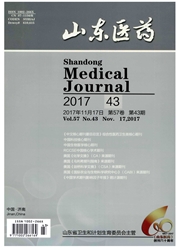

 中文摘要:
中文摘要:
目的检测非小细胞肺癌(NSCLC)患者肿瘤相关巨噬细胞表型及其分布,探讨NSCLC患者预后与肿瘤相关巨噬细胞各表型的关系。方法收集47例有完整临床病理和随访资料的NSCLC标本,运用免疫组化方法检测CD68、TNF-α、TGF-β1在肿瘤间质及癌旁肺组织巨噬细胞表达,分析其与患者各项临床指标及预后的关系。结果 CD6+8TNF-α+M1型巨噬细胞在NSCLC癌组织低于癌旁正常肺组织(P〈0.05),CD6+8TNF-β1+M2型巨噬细胞在NSCLC肿瘤间质高于癌旁正常肺组织(P〈0.05);M1型及M2型巨噬细胞在肿瘤间质内的数量与临床分期相关(P〈0.05);Kaplan-Meier生存曲线分析显示患者术后生存率随巨噬细胞TNF-α阳性表达而呈上升趋势,随TGF-β1阳性表达呈现下降趋势。结论 M1型巨噬细胞减少和M2型巨噬细胞增多与NSCLC患者的不良预后有关。
 英文摘要:
英文摘要:
Objective To study the relationship between the tumor-associated macrophage phenotypes and the clinical prognosis of non-small cell lung cancer(NSCLC) patients.Methods Immunohistochemical staining for CD68,TNF-α and TGF-β1 were performed on paraffin embedded tissues from 47 NSCLC cases.The relationship between immunohistochemical staining results and the relative clinicopathologic data and prognosis of NSCLC patients were analyzed.Results CD+68TNF-α+ macrophage(M1) was significantly lower in NSCLC than that in tumor surrounding lung tissues(P〈0.05) and CD+68TNF-β+1 macrophage(M2) was significantly higher in NSCLC than that in tumor surrounding lung tissues(P〈0.05).M1 and M2 macrophages expression were correlated with clinical stage(P〈0.05).Kaplan-Meier analysis showed that up-regulating of CD+68TNF-α+ macrophage expression was associated with higher survival rate of patients after operation,up-regulating of CD+68TNF-β+1 macrophage expression was associated with lower survival rate of patients after operation.Conclusion M1 macrophage decreasing and M2 macrophage increasing were correlated with lower survival rate of NSCLC patients after operation.
 同期刊论文项目
同期刊论文项目
 同项目期刊论文
同项目期刊论文
 期刊信息
期刊信息
